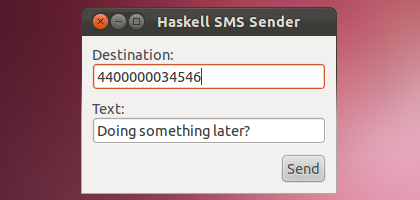Android
,
FRP
,
Functional Programming
,
Functional Reactive Programming
,
Game Programming
,
Haskell
,
Open Source
,
Reactive
,
Reactive Banana
,
Yampa
A new version of Yampa is out (0.9.6)
Yampa is an impressive, arrowized, Functional Reactive Programming (FRP) implementation written in Haskell. We are using it to implement Android games at Keera Studios, and it has been used, among others, to implement the video game Frag (see video below). Today, a new version of Yampa sees the light. This new version includes a substantial amount of Haddock documentation and a couple new combinators.
...
Android
,
Apple
,
FRP
,
Functional Programming
,
Functional Reactive Programming
,
Game Programming
,
Games
,
Haskell
,
Ios
,
Iphone
,
Open Source
,
Reactive
,
Yampa
The most inspiring green screen you will ever see
While Haskell, Idris and other Functional Programming (FP) languages enable writing elegant code, the road to production is, well, bumpy. Writing code for industrial environments has added costs that make certain products too expensive and infeasible in practice. That is why, when a new business model is available for FP-ers, the community wins. That is why you are about to see the most inspiring green screen you will ever come across.
...
Functional Programming
,
Game Programming
,
Games
,
Haskell
,
Linux
,
Open Source
,
Wii
,
Wiimote
Interacting with your Haskell Games using the Wiimote
Quite recently we have been focusing our attention on using new input devices in Haskell games. Wiimotes have many sensors, they are very cheap, and people have been hacking them for a long time.
...
Functional Programming
,
Gtk
,
Gtk2hs
,
Gui
,
Hails
,
Haskell
,
Open Source
,
Reactive
,
UI
Delving into Reactive Values
In a previous posts we examined the current state of GUI programming in Haskell, how imperative libraries get in the way of functional beauty, and how (non-FRP) reactive programming enables short, declarative code and facilitates code reuse. But without the low-level details, without more information on how this framework is structured, all we have is an idea, a draft on a piece of paper. It’s impossible to know how much effort it will require, or how much it will affect our code.
...
Reactive Programming using Reactive Values
If you’ve read previous posts about GUI programming in Haskell, you’ll know that reactive programming allows us to write simpler, less coupled controllers and to move much of our logic to the model of our applications. But how can we realise such stateful elements in Haskell? Meet Reactive Values.
...
FRP
,
Functional Programming
,
Functional Reactive Programming
,
Gtk
,
Gtk2hs
,
Haskell
,
Reactive
,
UI
GUI programming in Haskell "the old way"
As discussed in a previous post, purely functional GUI frameworks may fail to deliver in terms of feature coverage, look-and-feel and codebase scalability. As a result, many programmers turn back to good-old Gtk+ for their user interfaces (see, for instance, Ian-Woo Kim’s hoodle).
...
Board Games
,
Functional Programming
,
Games
,
Gtk
,
Gtk2hs
,
Haskell
Creating board games in Haskell in 100 lines of code
While code written in Haskell is very declarative and mathematical, as soon as we try to create a user interface, we’ll be slapped on the cheek by a wave of IO that will turn our code procedural in no time. One of the main ideas behind this gaming (ad)venture called Keera Studios is to write more mathematical, robust games. We want these games to be easy to understand and expand, and we want them to look good too.
The current trend in this respect is based mostly on FRP. However, FRP is still on its way, and no Haskell implementation (AFAWK) performs really well. (We recently tried all of them, and found that there’s still a lot to be done to be able to fully rely on FRP for interactive applications).
In this post we’ll see that, through an ad-hoc layer that will hide most of the controller and separate the UI from the mathematical model, we can implement nice-looking games in Haskell that have declarative, pure definitions and use graphics efficiently for the implementation.
...
Keera Hails: functional event-driven programming of desktop applications in Haskell
Some time ago I tried to create big programs with user interfaces in Haskell and found that none of the FRP frameworks worked as expected. Some were incomplete, others didn’t compile, and efficiency was an issue in those that did work.
...



